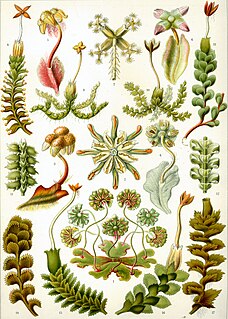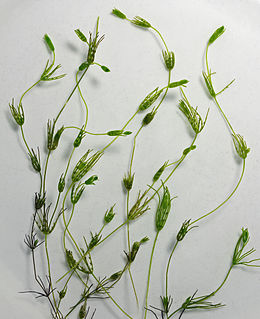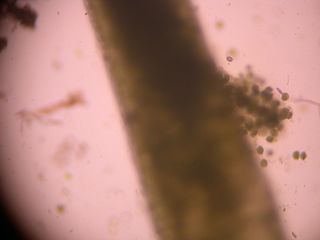
Ceratophyllum is a cosmopolitan genus of flowering plants including four accepted living species in 2016, commonly found in ponds, marshes, and quiet streams in tropical and in temperate regions. It is the only extant genus in the family Ceratophyllaceae, itself the only extant family in the order Ceratophyllales. They are usually called coontails or hornworts, although hornwort is also used for unrelated plants of the division Anthocerotophyta.

Ceratophyllaceae is a cosmopolitan family of flowering plants including one living genus commonly found in ponds, marshes, and quiet streams in tropical and in temperate regions. It is the only extant family in the order Ceratophyllales. Species are commonly called coontails or hornworts, although hornwort is also used for unrelated plants of the division Anthocerotophyta.

Bryophytes are a hypothetical taxonomic division containing three groups of non-vascular land plants (embryophytes): the liverworts, hornworts and mosses. They are characteristically limited in size and prefer moist habitats although they can survive in drier environments. The bryophytes consist of about 20,000 plant species. Bryophytes produce enclosed reproductive structures, but they do not produce flowers or seeds. They reproduce via spores. Though bryophytes were considered a paraphyletic group in recent years, almost all of the most recent phylogenetic evidence supports the monophyly of this group, as originally classified by Wilhelm Schimper in 1879. The term "bryophyte" comes from Greek βρύον, bryon "tree-moss, oyster-green" and φυτόν, phyton "plant".

The Marchantiophyta are a division of non-vascular land plants commonly referred to as hepatics or liverworts. Like mosses and hornworts, they have a gametophyte-dominant life cycle, in which cells of the plant carry only a single set of genetic information.

Hornworts are a group of bryophytes constituting the division Anthocerotophyta. The common name refers to the elongated horn-like structure, which is the sporophyte. As in mosses and liverworts, the flattened, green plant body of a hornwort is the gametophyte plant.

Non-vascular plants are plants without a vascular system consisting of xylem and phloem. Instead, they may possess simpler tissues that have specialized functions for the internal transport of water.

Dendroceros is a genus of hornworts in the family Dendrocerotaceae. The genus contains about 51 species native to tropical and sub-tropical regions of the world.
Megaceros is a genus of hornworts in the family Dendrocerotaceae. The genus is found in the Old World tropics of east Asia and Australia. Its name means 'big horn', and refers both to the exceptionally large size of the gametophyte thallus and to the large, horn-shaped sporophyte that the plants produce. Many species have a branching thallus that is more than two centimeters wide. The gametophytes are monoicous.
An elater is a cell that is hygroscopic, and therefore will change shape in response to changes in moisture in the environment. Elaters come in a variety of forms, but are always associated with plant spores. In many plants that do not have seeds, they function in dispersing the spores to a new location. Mosses do not have elaters, but peristomes which change shape with changes in humidity or moisture to allow for a gradual release of spores.
Notothylas is a genus of hornworts in the family Notothyladaceae. The genus is found globally, but is usually overlooked. It is the smallest of all the hornworts, with a yellow-green gametophyte thallus that is seldom more than a centimeter in diameter, and usually much smaller.

The Notothyladaceae is the only family of hornworts in the order Notothyladales.
Folioceros is a genus of hornworts in the family Anthocerotaceae. The genus is common locally in the tropical and subtropical regions of Asia, growing on moist rocks, in fallow fields, and near waterfalls. It has a yellow-green gametophyte thallus that is crispy and translucent, with short branchings that are almost pinnate. Plants are usually less than a centimeter wide and 3 centimeters long. They may be monoicous or dioicous.

Ceratophyllum demersum, commonly known as hornwort, rigid hornwort, coontail, or coon's tail, is a species of Ceratophyllum. It is a submerged, free-floating aquatic plant, with a cosmopolitan distribution, native to all continents except Antarctica. It is a harmful introduced weed in New Zealand. It is also a popular aquarium plant.
Leiosporoceros dussii is the only species in the hornwort genus Leiosporoceros. The species is placed in a separate family, order, and class for being "genetically and morphologically distinct from all other hornwort lineages." Cladistic analysis of genetic data supports a position at the very base of the hornwort clade. Physical characteristics that distinguish the group include unusually small spores that are monolete and unornamented. Additionally, there are unique strands of Nostoc (cyanobacteria) that grow inside the plant parallel with its direction of growth. Male plants have been found in Panama.
Cyanobionts are cyanobacteria that live in symbiosis with a wide range of organisms such as terrestrial or aquatic plants; as well as, algal and fungal species. They can reside within extracellular or intracellular structures of the host. In order for a cyanobacterium to successfully form a symbiotic relationship, it must be able to exchange signals with the host, overcome defense mounted by the host, be capable of hormogonia formation, chemotaxis, heterocyst formation, as well as possess adequate resilience to reside in host tissue which may present extreme conditions, such as low oxygen levels, and/or acidic mucilage. The most well-known plant-associated cyanobionts belong to the genus Nostoc. With the ability to differentiate into several cell types that have various functions, members of the genus Nostoc have the morphological plasticity, flexibility and adaptability to adjust to a wide range of environmental conditions, contributing to its high capacity to form symbiotic relationships with other organisms. Several cyanobionts involved with fungi and marine organisms also belong to the genera Richelia, Calothrix, Synechocystis, Aphanocapsa and Anabaena, as well as the species Oscillatoria spongeliae. Although there are many documented symbioses between cyanobacteria and marine organisms, little is known about the nature of many of these symbioses. The possibility of discovering more novel symbiotic relationships is apparent from preliminary microscopic observations.

The Anthocerotaceae is the only family of hornworts in the order Anthocerotales.

Nothoceros is a genus of hornworts in the family Dendrocerotaceae. The genus is found in New Zealand, South America, and neotropical and eastern North America.
Phymatoceros is the only genus in the hornwort family Phymatocerotaceae and order Phymatocerotales. It includes only two species.
Phaeomegaceros is a genus of hornworts in the family Dendrocerotaceae. It includes seven species.
Botany is a natural science concerned with the study of plants. The main branches of botany are commonly divided into three groups: core topics, concerned with the study of the fundamental natural phenomena and processes of plant life, the classification and description of plant diversity; applied topics which study the ways in which plants may be used for economic benefit in horticulture, agriculture and forestry; and organismic topics which focus on plant groups such as algae, mosses or flowering plants.









